Nanotechnologies in Construction: A Scientific Internet-Journal @nanobuild-en
Статьи журнала - Nanotechnologies in Construction: A Scientific Internet-Journal
Все статьи: 572
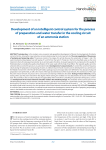
Статья научная
Introduction. In the modern socio-economic and geopolitical development of Russia, the development of industry comes to the fore. Among the many industries, ammonia stations play the most important role. The main regularities of the process of pumping and preparing water. The process consists of six stages, this article discusses the automation of stages 1 and 2: for water treatment and pumping it out with pumps H1 and H2 from the tank P2. Products in the form of purified water are the most important criteria for subsequent production at an ammonia plant, therefore, increased requirements are imposed on the quality of finished products, including the quality of purification of the water used with the help of nanofilters. The required quality cannot be achieved without control the process in an automated mode. Development of a neural network. To control the converters frequency values during the preparation and pumping of water, an artificial neural network must be used. Its development was carried out in the Matlab environment in the Neural Network Toolbox package, input and output data were defined for this, data processing and preparation were performed, as well as the choice of the type and architecture of the neural network. The architecture of the Layer Recurrent neural network, the process of its construction and training in Matlab is described. Testing of neural networks. During testing of the Layer Recurrent network for the degree of their training, the smallest error was obtained for 30 neurons in the hidden layer. The proximity to the set values indicates the applicability of the network for controlling the parameters of frequency converters. Development of the neural network controller model in the Simulink package. The simulation of the control system in the Simulink package using a neural network controller with the Layer Recurrent architecture is performed. Checking the frequencies of the frequency converters H1 and H2 in Simulink for the level parameters in the tanks and in the tank LT1_вх, LT2_вх, LT3_вх showed that the object model works correctly, thus, the simulation of the neural network showed that the training was successful. Conclusion. As a result of the conducted research, an artificial neural network was developed to control the process of preparing and pumping water in the Matlab environment and a simulation of a neural network in the Simulink package.
Бесплатно
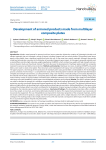
Development of armored products made from multilayer composite plates
Статья научная
Introduction. Modern requirements for personal and local armor protection dictate the creation of lightweight, durable, and efficient materials that can withstand a variety of threats, including shrapnel and low-velocity bullets. Conventional metal armor panels, while reliable, have a significant weight that limits their use. At the same time, ceramic materials, although they provide a high level of protection, are prone to the formation of secondary fragments upon impact. In this regard, composite materials such as aramid fibers and ultra-high-molecular-weight polyethylene (UHMWPE), which combine low weight with high strength and resistance to dynamic loads, are of particular interest. The article discusses the development of multilayer plates made from composite materials for personal and light armor protection. Methods and materials. Multilayer structures, including UHMWPE and aramid fabrics, were used to create armor plates. These structures were impregnated with epoxy resin and bioadditives such as collagen. The paper proposes a technology for the production of multilayer plates using aramid fabric and bioadditives. The technological process consisted of several steps: 1) a comprehensive study of the selected polymer materials with experimental determination of rigidity and strength characteristics; 2) cutting the fabric using a laser machine; 3) manufacturing an armor plate depending on the material and the loads subjected to it. Composite plates made from UHMWPE were created through hot molding using a press mold, and they consist of varying numbers of material layers. Multilayer elements (up to 30 layers) were made from aramid fabric with epoxy resin with bioadditives, which impart new elastoplastic properties to the material. Results. The ANSYS software package was used to calculate the strength of a multilayer composite plate under shock loading; field testing of the obtained plates as armor protection were also conducted, demonstrating good agreement with the calculations. Discussion. The obtained combined armor plates are highly effective in absorbing kinetic energy and preventing fragment penetration. Adding bioadditives to the epoxy matrix increased the interlayer defect zone, which contributed to the dissipation of impact energy. According to the authors, when adding bioadditives, the material acquires high fracture toughness. Conclusion (Findings). The developed armor plates offer a combination of low weight, no ricochets, and minimal deformation behind the barrier. This makes them promising for use in personal and local protective equipment. The use of bioadditives has improved the mechanical properties of the composite materials, and the test results confirm that the products comply with the Br3 protection grade, with a weight reduction of 25–30% compared to the analogues. The resulting products (low weight, absence of ricochet and traumatic consequences after impact) make them suitable for use as protection against shrapnel and pistol bullets.
Бесплатно
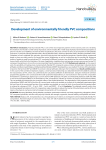
Development of environmentally friendly PVC compositions
Статья научная
Introduction. Polyvinyl chloride (PVC) is one of the most important polymers in the economy. Due to its versatility, this material is now found in a wide variety of products used in everyday life. A wide range of physical and mechanical properties is given to it by the use of additives, the main of which are plasticizers. The most common in terms of consumption are orthophthalic acid esters, in particular, dibutyl phthalate (DBP), dioctyl phthalate (DOP), diisononyl phthalate (DINP), diisodecyl phthalate (DIDP). Phthalates are well combined with polymers, give them high physical and mechanical properties, therefore plastic compounds based on them are widely used in the construction sector, engineering, as well as in agriculture and in everyday life. Numerous studies of products made from plasticized PVC, conducted in different countries, have established the adverse effects of DOP on human health, which led to the limitation of its areas of application. Legislative bans and growing consumer pressure are forcing PVC compound manufacturers to look for an environmentally friendly replacement for DOP. Methods and materials. In this research work, the possibility of creating more environmentally friendly PVC compounds using a mixture of plasticizers: industrial dioctyl phthalate and diisononyl phthalate and dibutoxyethyl phthalate (DBOEP) developed by us was studied. The choice of the plasticizers is based on the fact that DINP and DBOEP, in contrast to dioctyl phthalate, belong to the 3rd hazard class. Results and discussion. In the course of the correlation-regression analysis, a close functional relationship was obtained between the additives used and the characteristics of PVC, which was confirmed by the calculated coefficient of determination. Using the method of nonlinear programming applied to the constructed third-order polynomial dependencies, it was found that in the basic PVC composition formulation it is promising to replace up to 25 wt.h. DOP on DINP plasticizer. The joint use of industrial plasticizers DOP and DINP, as well as the developed DBOEP in the formulation of PVC compositions, indicates an increase in plasticity and manufacturability. This can probably be explained by the synergistic effect of the studied plasticizers. The dependence of the properties and content of plasticizers DBOEP and DINP in the form of a second-order surface was studied on the basis of the obtained experimental data, the level lines of the constructed function of two variables were studied, as a result of which it was found that the greatest effect is achieved at a dosage of: DOP – 25 wt.h., DINP – 5 wt.h. and DBOEF – 20 wt.h. Conclusion. The obtained research results show that the proposed formulation of the PVC composition makes it possible to reduce the toxicity of the plasticizers used by 50 % and improve the physical, mechanical and technological characteristics of the compounds.
Бесплатно

Development of heavy metal-based nanostructured complex technology for use in building mortar
Статья научная
Introduction. Heavy metals (copper, zinc, nickel, lead, chromium, cobalt, cadmium) get into constructional materials with natural and man-made raw materials. The chemical and mineralogical composition of large-tonnage wastes from the petrochemical industry is perfect for constructional materials production. Heavy metals in constructional compositions provide high strength and frost resistance. Currently, nanostructured metal-containing complexes are used in the production of mortars. Therefore, it is necessary to ensure the reliable binding of heavy metals into structurally stable compounds to avoid their emission and secondary environmental pollution. The steadily growing volumes of sludge reservoirs with high concentrations of heavy metals such as chromium (Cr +6), copper (+2), lead (+2), iron (+2), and Fe (+3) cause particular interest to researchers. Qualified extraction of the listed metals and binding them as nanocomponents in the composition of the complexing agent will ensure the creation of a nanostructural composition in the recipe for the preparation of mortar for various purposes. Methods and materials. Sorption methods are the main way to isolate heavy metals. The paper proposes a method for the production of alkyleneaminopolycarboxylic acids and studies its ability to form nanometallic complex compounds for the extraction of heavy metals. Results and discussions. In order to bind metal nanoparticles in oil sludge, the efficiency of the produced compounds, carboxymethyl derivatives of hexamine, was investigated. Optimum synthesis conditions were selected and the structure of the obtained complexing agents was proved by infrared and ultraviolet radiation methods as well as by the method of nuclear magnetic resonance. Conclusion. The resulting nanostructured additions have binding properties that provide high adhesion of the heavy metal to the organic substrate and mortar components, which makes it possible to provide a strong composition that maintains operational properties that meet technical requirements.
Бесплатно
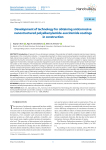
Статья научная
Introduction. At present, the use of polymer coatings in the protection of metallic materials and structures is becoming popular in the construction industry. It is especially important to obtain nanostructured polymer insulating materials with high anticorrosive properties in order to ensure the service life of the equipment of the fuel and energy complex. Technological equipment during the extraction, transportation, processing of petrochemical raw materials is subject to regular exposure to aggressive environments. Damage to production equipment causes annual environmental damage and human health and material burden on the enterprise. The introduction of heteroatoms into the structure of the polymer molecule helps to improve the physico-chemical characteristics of polymer coatings, in particular, to increase the protective properties, since natural and synthetic polymer compounds represent a large cluster of supramolecular structures located in a certain sequence. Methods and materials. A technology has been developed for obtaining new polymeric nanostructured alkenylsuccinimides with anticorrosive properties, which can be used as part of lubricating coatings in various industries, including construction. Alkenylsuccinimides were tested according to TS 38101147-77 for succinimide additives and showed compliance with their standards TS 38101247-77. Results and discussions. In the course of the research a resource-saving non-waste technology of obtaining a nanostructured polymer additive with polyamines as a nanostructuring base to provide an anticorrosive effect has been developed. Conclusion. The obtained compounds based on triethylenetetramine, tetraethylenepentamine, alkenylsuccinic anhydride can be used as effective polymeric anticorrosion additives in the processing of metal materials and structures in the construction industry.
Бесплатно
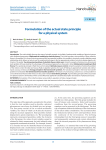
Development of the actual state principle for a physical system
Статья научная
Introduction. The article briefly discusses the state of scientific research in the field of mathematical modeling of physical systems with distributed parameters. Mathematical modeling in elasticity theory. The initial boundary value problem of linear elasticity theory is formulated. It is shown that using measured and unmeasured variables, it is possible to construct a positive definite energy relationship, which allows not only to use the variational technique to find an approximate solution, but also to design objective estimates of its quality. Two-dimensional problem of elasticity theory (static case). Using the example of solving a two-dimensional static problem of linear elasticity, the advantages of the proposed approach are discussed in detail. Mathematical modeling in fluid theory. The variational principle in fluid theory is formulated. Optimal pressure control. Using the example of solving the problem of the motion control for ideal and viscous fluids in pipeline systems, the issues of finding an approximate solution and estimating its accuracy are discussed. Energy principle in the heat transfer problem. The variational principle in the linear heat transfer problem is formulated. Two-dimensional heat transfer problem. The features of constructing a solution to a control problem in a two-dimensional heat transfer theory are discussed in detail. Generalizing principle. A generalizing principle of the actual state of a physical system is formulated, which can be effectively applied for a detailed description and analysis of physical processes.
Бесплатно
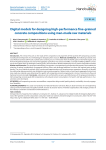
Статья научная
Introduction. This research focuses on the study of the composition and properties of fine-grained self-compacting concrete, including the development of a methodology for designing their structure. Methods and Materials. The following materials were used: Portland cement CEM I 42.5B; crushed stone screening of 2.5–5 mm fraction from the Kurlek quarry in the Tomsk region; sand from the Tuganskoye deposit was used as fine aggregate; quartz flour was used as microfiller; a complex modifying additive consisting of microcalcite from the Dalnegorsk mining quarry and nanosilicon dioxide obtained by the arc plasma evaporation method. Results and Discussion. The proposed methodology incorporates a computational and experimental approach that enables the selection of optimal combinations of aggregate fractions, fillers, and developed additives to achieve the required grain packing density. The use of statistical methods, such as polynomial approximation and Gaussian process regression, allowed us to identify the relationship between particle size distribution and concrete properties. Optimal ratios of each quartz aggregate fraction from man-made raw materials were determined for specific self-compacting concrete requirements in terms of concrete mix flow and hardened concrete strength. Conclusion. Laboratory tests confirmed the accuracy and effectiveness of the proposed calculations. Self-compacting concrete grade B40 compositions with reduced cement consumption (412 kg/m3) and high-performance` characteristics were developed.
Бесплатно
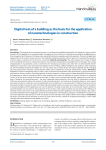
Digital twin of a building as the basis for the application of nanotechnologies in construction
Статья научная
Introduction. The purpose of the conducted research is to analyze the possibilities provided by the “digital city” system and the prospects for the application of nanotechnologies. The objective of the research is to determine the possibility of digitalization in city management and the process of making more substantiated decisions regarding real estate operation. The practical application opportunities of the research results are due to the feasibility of implementing the author's approach to analyzing the operation of urban systems in general and “smart home” in particular. Methods and materials. The article explores the concept of “digital twin of a building,” its functions, components, features of construction and operation using digital twin technologies. The concept of digitalization is characterized, as well as mechanisms for introducing innovations into urban life. It is demonstrated that the “digital city” incorporates various innovative technologies: Internet of Things, artificial intelligence, data analytics, cloud computing, etc. The technologies utilized by the “digital city" not only collect data on urban life but also employ obtained data for managing electricity supply, waste collection, ensuring people's safety, and as elucidated in the article, transportation systems. Discussion. Digitization in urban management helps to create a more convenient and sustainable urban environment, a goal pursued by the governments of many countries. The implementation of sensors, detectors, and the analysis of data obtained from them provides an opportunity to improve the quality of life for urban residents and increase the efficiency of resource utilization. As a pleasant “bonus,” all of this allows making the living environment of citizens more environmentally friendly, addressing an issue that has been a “headache” for many governments – the issue of greening human existence in the city. After all, reducing the number of traffic jams automatically reduces the amount of carbon dioxide emissions, and turning on city lighting based on sensor signals saves electricity due to a reduction of consumed kilowatts since the bulbs are not unnecessarily lit. To address these issues, the use of nanotechnologies is proposed, which will enable ordinary building materials to acquire new unique properties. The emergence of nanotechnologies and their application can solve the problem of energy conservation in the construction industry. Moreover, nanotechnologies not only allow for the production of new products with unique properties but also enhance the efficiency of materials used in construction. In this regard, the key question for determining the application of nanotechnologies is the exploration of their integration into the digitization system of city management, which already incorporates a multitude of innovations and new technologies that help optimize the work of municipal services and improve the quality of life for urban residents. Conclusions. The author concludes that the provision of services by many urban services is based on 3D design technologies, as well as data collected within the framework of the “digital city” system.
Бесплатно
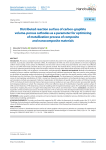
Статья научная
Introduction. The porous composite and nanocomposite materials discussed in this publication are metallized carbon-graphite materials, in particular carbon fiber materials (CFMs). At metallization of CFMs one of the actual problems is the task of applying uniform metal coating on the surface of CFMs fibers over the entire volume of the processed material. One of the most effective ways to coat CFMs with metals and their alloys is the galvanic method. This method allows, among other things, to optimize the process by optimizing both the design of the electrolyzer with flow-through three-dimensional electrodes (FTE) and the choice of electrodeposition modes, such as galvanic, concentration, and hydrodynamic. Materials and methods. Methods of mathematical modeling of porous medium metallization processes and previously published experimental data were used to solve problems on calculation of operating modes and elements of the electrolyzer design, in particular, the specific reaction surface of the UWM distributed over the thickness of the electrolyzer. Results and discussion. The development of mathematical models of the processes of electroplating metallization of CFMs is carried out. Boundary value problems of mathematical physics are formulated and calculation methods are proposed. Problems of optimization of distribution of specific reaction surface of CFMs by thickness of FTE on the basis of electrochemical theory of processes in porous medium are set, ways of their solution are presented. Specific technological problems are solved. The comparison of the most effective values of the distribution of specific reaction surface of CFMs over the thickness of FTE obtained as a result of modeling with the experimental data is given. The workability of models and methods for studying the process of copper electrodeposition from sulfuric acid electrolyte is shown. Conclusion. Calculation of regularities of electrochemical processes of metal extraction in FTE on the basis of the developed mathematical models allows to predict the results of electrolysis, determine the optimal modes of operation and elements of FTE design. The use of FTE for metallization of CFMs with properly distributed reaction surface contributes to obtaining composite materials with specified properties.
Бесплатно
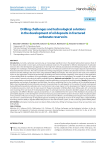
Статья научная
Introduction. Currently, carbonate reservoirs play an increasingly significant role in the global hydrocarbon balance. Most of the deposits discovered in recent years are fractured carbonate reservoirs. The potential for effective development of carbonate reservoirs lies in the development and application of new high-tech methods and advanced well drilling technologies. The article highlights the challenges of developing productive deposits in the Paleozoic basement of Tomsk region deposits represented by fractured carbonate reservoirs. The article considers the mining and geological conditions of carbonate reservoirs in the Paleozoic basement and the challenges that arise when using traditional drilling technologies. The article presents the results of an analytical review on the application of advanced technologies for drilling wells with horizontal completion. Some aspects of the application of nano drilling fluids for conditions of low-permeability carbonate reservoirs are highlighted. The content of the article is based on the author's research and analysis of publicly available literature. Methods and materials. The work is based on the generalization, systematization and analysis of factual material, scientific publications, and results of analytical studies. Results. Based on the generalization and analysis of geological and field data, the authors established that in the conditions of the identified group of fields, when developing fractured carbonate reservoirs, the productivity of a well depends on the number of natural cracks opened during drilling that penetrate carbonate rocks. Fault tectonics had a major impact on the development of highly fractured zones of carbonate reservoirs, which are the main reason for frequent absorption of drilling fluid when drilling wells with a horizontal end. Clustering of the well stock of the development object in carbonate reservoirs allowed to identify 3 groups of wells, opening up deposits with different filtration-capacity characteristics. It was established that the nature of the distribution of porosity and permeability depends on the development of reservoir fracturing associated with the position of tectonic faults. Analytical studies in the perimeter of Russian oil and gas companies have shown that the efficiency of well drilling technologies in fractured carbonate reservoirs is achieved through an integrated approach: detailing the geological structure of the target object, adapted drilling technology with the ability to regulate differential pressure in the well-formation system, as well as selecting optimal drilling fluids.
Бесплатно
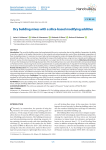
Dry building mixes with a silica-based modifying additive
Статья научная
Introduction. The use of dry building mixes has broad potential for use in construction due to their stability of properties, the ability to provide a specific set of quality characteristics to the material, and reduced production waste. When developing compositions of floor dry building mixes, it is necessary to ensure high mechanical properties, reduce shrinkage deformations, crack formation, and provide high adhesion to the concrete base. Expanding the range of dry building mixes, using local raw materials and modifying additives for various functional purposes for their production is an urgent task for the construction industry. Materials and methods. To ensure the rheological and technological properties of the dry building mixes, low water demand binders were produced based on Portland cement, volcanic slag, fly ash and dry superplasticizer on a polycarboxylate basis. To regulate the technological properties and increase mechanical properties of dry building mixes, a reinforcing additive in the form of basalt fiber and nanosilica was used. Results and discussion. The compositions of self-leveling dry building mixes were optimized according to the criteria for achieving the highest mechanical properties. The water-holding capacity of the mixes, compressive and flexural strength, water absorption, crack width, abrasion, and adhesion strength to the concrete base were determined. The microstructure of the mortar was studied using scanning electron microscopy. An assessment was made of the influence of modifying additives on changes in the properties of flooring dry building mixes. Conclusion. The resulting compositions of dry building mixes comply with the requirements of state standard for self-leveling flooring building mixes. With the use of a complex of mineral, plasticizing, micro-reinforcing, nano-sized additives, high performance indicators of flooring building mixes have been achieved.
Бесплатно
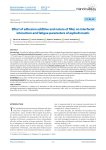
Статья научная
Introduction. The effect of adhesion additive and nature of filler on fatigue life and interfacial interaction in mastic is analyzed in this paper. Materials and methods of research. Frequency sweep from 0.1 to 100 rad/s at strain 0.05% at temperatures from 30 to –10°С with a step 10°С and cyclic tests (LAS test) at temperatures from 16 to 1°С with a step 3°С for bitumen grade BND 100/130 and mastics based on it, containing fillers of different nature, were performed on the dynamic shear rheometer. Mastics were prepared by mixing bitumen (3 min; 160°С and 600 rpm) and filler (filler volume fraction – 0.275). Adhesion additive in an amount of 0.7%, was introduced into bitumen before the filler to investigate the effect of AD on the properties of bitumen and AB. The damage characteristic curve under cyclic loads was calculated using two models of VECD theory (Viscoelastic Continuum Damage Modeling System): dissipated strain energy and pseudo-strain energy. Results and Discussion. The influence of nature and properties of filler, adhesive additive, temperature and frequency of tests on the parameter of interfacial interaction K-B-G* and thickness of adsorbed layer has been investigated. The intensity of damage in the specimen under cyclic loads and the behavior of fatigue parameters as a function of test temperature at two variants of determining the parameter α have been analyzed. Conclusion. It is shown that an increase in the interfacial layer thickness in asphalt mastic leads to an increase in their resistance to damage accumulation (Damage Intensity) during fatigue testing (LAS), and lowers the rate of pseudo-deformation energy growth.
Бесплатно
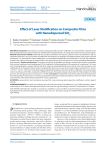
Effect of laser modification on composite films with nanodispersed SiO2
Статья научная
Introduction. This research is aimed at studying the effect of laser modification on composite films obtained on the basis of polyimide track (nuclear) membranes and filled with nanodispersed SiO2; to change their optical and structural properties. Materials and research methods. Polyimide track (nuclear) membranes were used as a polymer matrix. Track diameter is 200 nm, membrane thickness is 25 μm. The tracks were filled with nanosized SiO2 by hydrolysis of tetraethoxysilane in the presence of track membranes. For composite film surface modification, we used ytterbium pulsed fiber laser Minimarker 2-20 A4 PA. We studied the change in the surface microscopy of composite films, their optical density, IR-Fourier spectra and surface wettability depending on laser treatment. Results and discussion. The authors have found the possibility of creating a composite film based on a polyimide track (nuclear) membrane and nanodispersed SiO2 by hydrolysis of tetraethoxysilane in the presence of a membrane. It is shown with the energy dispersive analysis method that silicon oxide has completely filled the pore volume of the track membrane. Laser modification of the composite material surface (composite film) leads to an increase in the contact angle of wetting from θ = 66.75 ± 1.55° to θ = 101.52 ± 3.03°. Thus, the material acquires hydrophobic properties. Also, the laser films modification has a positive effect on the transmittance of the films, namely, this coefficient increases. The greatest change is observed in the infrared region of еmitted spectrum, the average increase in transmission is +70.48%. Conclusion. The obtained results of the study are of great importance for understanding the mechanisms of creating composite films with improved optical properties, which can later be used to create composite films with desired optical properties for various applications.
Бесплатно
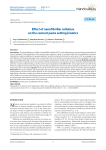
Effect of nanofibrillar cellulose on the cement paste setting kinetics
Статья научная
Introduction. The study addresses the effect of nanofibrillar cellulose (NFC) on the setting process of cement paste during the first hours of gauging. A brief justification of the research topic relevance is given. It has been noted that the modification of cement materials by nanoscale additives has sparked significant scientific and practical interest in recent years. NFC has emerged as one such additive, and the potential impacts of its incorporation into cement systems are currently under active investigation. The study aims at investigating the effect of NFC on the cement paste setting kinetics during the first hours of gauging. Materials and methods. We present the materials used in the research and their characteristics, in particular, two types of cement characterized by the presence or absence of false setting, as well as cement paste compositions with different NFC consumption (from 0 to 0.24% of dry matter by weight of cement). The technique of measuring conditional viscosity in time with a laboratory rheometer and a special measuring system is described. Results. The results of cement paste tests are presented in the form of setting process diagrams. Discussion. The results obtained and experimental data are given. The complex character of NFC influence on the cement paste setting kinetics has been noted, which depends on the cement quality and additive consumption. For cement without signs of false setting, a decrease in setting onset time was observed when increasing the NFC content. Conversely, increase in the amount of NFC leads to an increase in the setting onset time for cements with signs of false setting. Conclusion. NFC has a noticeable effect on cement paste setting kinetics in the first 3 hours: it accelerates the process when using cement without false setting and slows down the setting when using cement with false setting.
Бесплатно
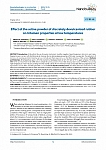
Статья научная
Introduction. In the article the use of powder elastomeric modifier capable of rapid breakdown into micro- and nanofragments upon contact with hot bitumen to improve the low-temperature properties of bitumen is presented. The indicators of resistance to cracking are determined by various methods and their dependence on the thermal history of the samples. Methods and Materials. At temperatures up to –36оC the oscillatory rheological tests (4-mm DSR test) of RTFO-aged samples of bitumen BND 60/90 and modified binder (MB) which contain the active powder of discretely devulcanized rubber (APDDR) produced by high-temperature shear-induced grinding from the crumb rubber of worn tires have been conducted. MB was prepared by mixing bitumen (3 min; 160оC and 600 rpm) with 12.5 wt.% APDDR. Results and Discussion. The effect of the test parameters on the rheological parameters has been studied. Structural transitions in bitumen and MB by methods of differential scanning calorimetry (DSC) and the cracking temperature of the same samples in static conditions in the ABCD test were detected. It is revealed: a decrease in the temperature of actual cracking of the MB sample compared to bitumen. Conclusion. It is shown that APDDR as a modifier affects the structure of bitumen and reduces the temperature sensitivity of bitumen to external influences.
Бесплатно
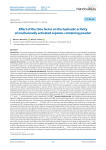
Статья научная
Introduction. The article examines the problem of the development of transport infrastructure in the Solovetsky archipelago and proposes a solution to reduce the cost of manufacturing reinforced concrete slabs for the road surface. It is proposed to use saponite-containing waste (SCW) of the mining and processing plant JSC Severalmaz as a mineral additive in concrete. Studies have shown that mechanically activated saponite-containing powder (MSP) improves concrete performance and reduces binder consumption. The use of MSP makes it possible to solve the problem of waste disposal and reduce environmental damage. The purpose of the work is to assess the effect of the time factor on the hydraulic activity of the mechanically activated saponitecontaining powder, since the activity of the additive may change during long-term storage. It is known that the degree of activity of mineral components is usually estimated by the amount of Ca2+ ions absorbed from a saturated lime solution. A number of direct analytical methods are available to monitor the change in Ca(OH)2 content over time during the course of the hydraulic reaction. This technique, based on the measurement of the potential of the ion-selective electrode, is fully suitable for monitoring the hydraulic activity of the MSP. Methods and Materials. Saponite-containing waste was used as the main material for the studies, which was isolated, dried and dispersed. A mechanically activated saponite-containing powder was thus obtained. Control of the degree of grinding of the obtained finely divided MSP samples was carried out according to the specific surface area (Ssp, m2/kg). To perform potentiometric analysis, an electrode system consisting of a measuring electrode with a calcium ion detection function (pCa) and a reference electrode was used. In preparation for the experiment, the calcium selective electrode of the Elite-041 model was kept for three days in a calcium chloride solution with a concentration of 0.01 mol/L. The electrode was then washed with distilled water and calibrated to solutions with concentrations (CCa) of 10–1, 10–2, 10–3, 10–4 and 10–5 mol/L, for which pCa = 1÷5. To study the sorption capacity, a lime solution with a concentration of 0.015 mol/l was prepared, as well as a suspension from samples of fine mineral saponite-containing powder. A solution of lime with a volume of 0.2 ml was successively added to the resulting suspension by a doser, while measuring the electromotive force (potential) of the system with continuous stirring. Based on the obtained potential values (mV), the concentration of calcium ions (Сfact Ca) in the bulk phase of the suspension was calculated using a predetermined calibration relationship. Further, using the algorithm for calculating the activity parameters of powders, according to potentiometry data, the maximum amount of absorbed calcium hydroxide (ΔССaO) was determined as the difference between the Сteor Ca and Сfact Ca, and the hydraulic activity coefficient . Results and Discussion. The resulting mechanically activated saponite-containing powder had a specific surface area of 196 m2/kg (10 min), 644 m2/kg (30 min), 1209 m2/kg (60 min), 1428 m2/kg (90 min) at different milling times. The preliminary calibration dependence of the potential of the electrode pair on the pCa value is characterized by the linear equation: E = –23,23pCa+520,35. It was found that when adding a lime solution to the suspension, an increase in EMF is observed due to the sorption of calcium ions by a mechanically activated saponite-containing powder. After reaching the threshold volume of the Ca(OH)2 solution, the potential stabilizes. With a further increase in the concentration of calcium ions, when their interaction with the MSP particles ceases, the E value increases again. Further, dependencies were obtained for all batches of the experiment, the difference of which lies only in the quantitative characteristics of the functional parameters. Initial value of electrode pair potential characterizes background concentration of calcium ions determined by their residual content in water and/or MSP. The obtained functional relationships of the Сfact Ca = f(Сteor Ca) for the test samples made it possible to determine the threshold values of the concentration of calcium ions in the solution, the excess of which creates their excess in the reaction medium. The built functional dependence of the G∞ = f(Ssp), showed that the G∞ reaches its maximum value already at a specific surface area of more than 600 m2/kg (30 minutes of grinding). Since the grinding of 10 minutes has little effect on the specific surface area of the saponite powder, which affects the value of the hydraulic activity coefficient of the MSP, the dependence of G∞ = f(Ssp) for grinding more than 10 minutes was considered.
Бесплатно
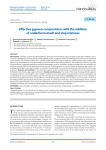
Effective gypsum compositions with the addition of underburned ash and slag mixtures
Статья научная
Introduction. Currently, research and development in the field of nanomaterials science is being conducted worldwide. The rationale for developing innovative energy-saving materials based on gypsum binders for buildings and structures with optimized carbon dioxide (CO2) emissions allows us to consider underburnt ash and slag mixtures as a promising technogenic product that allows us to comprehensively solve technological, economic and environmental problems in the construction industry. The study of the possibility of synthesizing promising mineral compositions based on underburnt products isolated from non-recyclable ash and slag mixtures (ASM) of coal-fired power plants ensures the development of a base of design and engineering solutions for buildings and facilities with rational energy consumption and optimized CO2 emissions using gypsum nanomaterials with unique properties. Materials and methods. In the study, technogenic carbon (underburning) was isolated from ash and slag mixtures by flotation enrichment using reagents (flotators). Results and discussions. The results of the study of energy-efficient gypsum composites based on a technogenic carbon modifier confirm its active participation in the processes of structure formation and crystallization of nanostructured building materials with high-tech characteristics. Conclusion. The research results obtained in the field of developing innovative, energy-efficient, cement-free building materials can contribute to an increase in the level of knowledge and the development of innovative approaches in construction materials science. These findings will be useful for subsequent implementation in the construction industry. The research topic is in line with the implementation of state programs, including the Strategy for Scientific and Technological Development of the Russian Federation.
Бесплатно
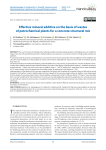
Статья научная
The use of concrete in building allows obtaining reliable and long-lasting operation of buildings, but such conditions require concrete with specified characteristics. Today hardly one can produce a concrete structural mix of high quality without any additives. To control actively the structure and properties of a concrete mix and concrete, along with chemical additives, mineral additives are used. The mineral additives are the powders of various mineral nature, obtained from natural or man-made raw materials: ground slag, rocks, etc. The article introduces the method of obtaining a mineral additive for a structural mix, in particularly for concrete. Qualitative characteristics of the additive obtained were studied as follows: the index of the degree of grinding to be equal to 1, standard consistency (normal density) – (180±5) mm with a mass ratio of «additive: water») – 100: 70, setting time – beginning 20 min, water absorption 0.27%, water content 9.65%, the proportion of insoluble residue in hydrochloric acid solution is 1.70%. Implementation of the additive in the concrete composition has shown that the quality of the product does not fall, and the actual strength is 250.7 kgf/cm2, which is slightly higher than the strength of the concrete sample without an additive. It was determined that the quality of concrete products with a mineral additive corresponds to GOST as follows: density 1775 kg/m3; mass humidity 0.3%; volume humidity 0.5%. The introduction of a structural mix will significantly improve the properties of a concrete structural mix and will also reduce the fuel resources consumption for production of the concrete structural mix, products and constructions of its basis.
Бесплатно
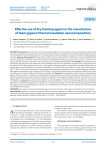
Статья научная
Introduction. The elaboration of foamed eco-friendly gypsum nanocomposites with low specific gravity, high thermal insulation, operational and technical and economic characteristics remains an urgent task. Controlled hardening of gypsum foam nanoassemblers using dry foaming agents is a promising direction in the technology of production of heat-insulating building materials. Methods and materials. The production of a foam gypsum composition was carried out in an ejector-turbulent mixer by mixing a gypsum nanobinder with functional foaming nanoadditives. Building gypsum G5 BII was used as a binder in the work; porization of gypsum compositions was carried out using an adsorbed foaming agent PBNS. Results. The transformation of liquid-phase foaming agents into solid-phase ones by binding water allows the production of gypsum foam compositions from dry mixtures, which gives high dosing accuracy, a good degree of homogenization of components and stable characteristics of foamed gypsum nanocompositions. In production conditions, a one-storey small-sized pavilion was built using a pilot 3D printer AMT S1160, in which vertical enclosing structures are filled with foamed heat-insulating nanostructured foam gypsum. Monolithic foam gypsum nanomaterial with a density of 300–400 kg/m3 was used for insulation and sound insulation of attic floors during the overhaul of the historic building of the Veterans Hospital in Ufa. Discussion. The elaboration of technology for obtaining foam gypsum from dry mixtures is based on the advantage of manufacturing and using thermal insulation nanocompositions, which allows for significant punctuality of dosing and stable characteristics of foam gypsum building materials. Surfactants have a significant effect on the kinetics of the structure formation of the foam gypsum nanocomposition and slow down the coalescence of air bubbles. Conclusions. Nanoporous foam gypsum concrete, obtained as a result of controlled hardening, with a density of 400 kg/m3 has a thermal conductivity of 0.12 W/(m•ºС) and a compressive strength of 1.4 MPa. The compressive strength of foamed foam gypsum using a dry foaming agent on sorbents is 17% higher than the strength of a heat-insulating nanomaterial prepared using traditional technology.
Бесплатно
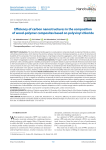
Статья
Introduction. The most effective binding agents in wood-polymer composites based on polyvinyl chloride are carboncontaining nanostructures, which improve the electrical, physical-mechanical, rheological properties, as well as the structure and durability of the composites. Their main disadvantage is a high degree of particle aggregation, which makes it difficult to mix and process them in polymer compositions. In this regard, an urgent task is to search for such carbon nanomodifiers that would have a low degree of aggregation and low cost. Methods and materials. The paper studies the effectiveness of mechanically activated petroleum cokes as binding agents in building wood-polymer composites based on polyvinyl chloride. Mechanical activation leads to the functionalization of carbon particles of coke with the formation of oxygen-containing groups on the surface. The effect of various amounts of coke (up to 10% of the mass of wood flour) is considered and the relationship between the nature of coke and their concentration in the polymer compositions with the main technological (melt flow) and operational (tensile and bending strength, high elasticity modulus, hardness, water absorption and thermal stability) indicators and supramolecular structure of woodpolymer composites has been identified. Results and discussion. With the introduction of cokes, a high degree of orientation of the supramolecular structures of the composites in the direction of extrusion of the samples is observed, which leads to an increase in the breaking strength and bending strength, as well as the high elasticity modulus. The optimal concentration of additives was determined from 0.1 to 5%. In relation to wood flour, the amount of which in the wood-polymer composition is 50 mass parts per 100 mass parts PVC. Conclusion. The introduction of mechanically activated petroleum cokes as binding agents in wood-polymer composites based on polyvinyl chloride has been carried out. Mechanical activation made it possible to reduce the aggregation of coke particles into larger agglomerates, which makes it possible to efficiently introduce the nanomodifier in dry form and to exclude the introduction of nanomodifier in the form of aqueous dispersions, which is a rather energy-intensive production operation.
Бесплатно

